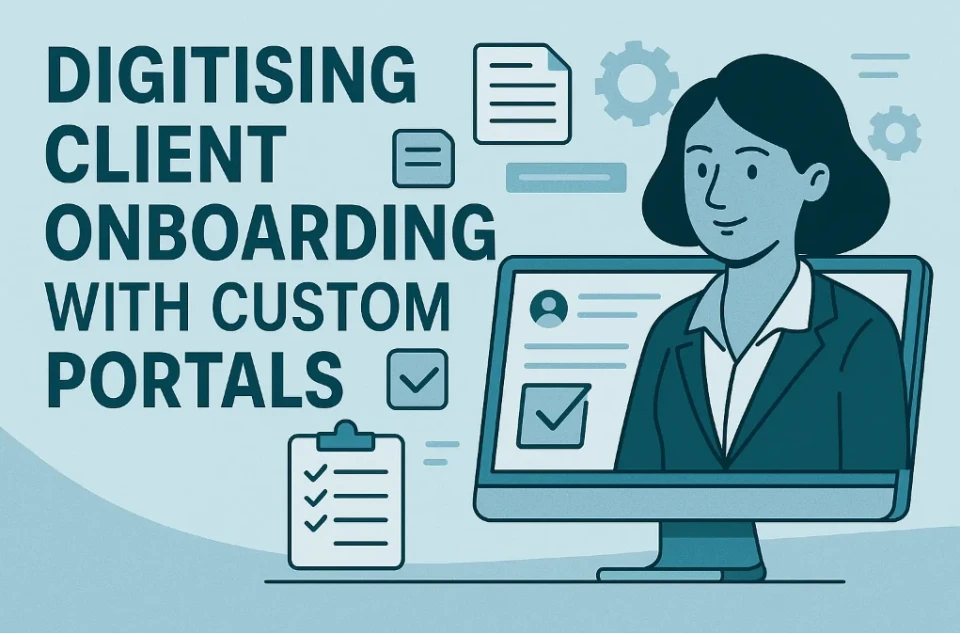Digitising Client Onboarding with Custom Portals
Manual onboarding processes, especially in compliance-heavy environments,are slow, error-prone, and hard to scale. This post explores how structured digital portals help organisations improve accuracy, traceability, and client experience, without the rigidity of traditional ERP systems.
The problem with Manual onboarding
Client onboarding is often where process friction becomes most visible:
- Forms passed around via email
- Spreadsheets used to track approvals
- Missed documents and inconsistent follow-ups
- Poor visibility across teams and unclear accountability
In compliance-driven sectors, these issues compound into operational risk and make a poor first impression on clients.
Real-world insight
We worked with a technical services provider where three different teams touched the same client file, but each had their own spreadsheet. Any misstep in version control meant the client had to repeat steps. It wasted time and eroded trust. The solution wasn’t just digitisation, it was restructuring the process into a unified, trackable flow.
Why off-the-shelf tools fall short
Form builders like Google Forms are fast to deploy, but aren’t designed for workflows with multiple decision points, role-based steps, or audit requirements. On the other end, many ERP systems impose a one-size-fits-all approach that doesn’t reflect how most mid-sized teams operate.
Most growing businesses are stuck between underpowered tools and overly rigid platforms.
A more flexible approach to workflow design
Rather than forcing teams into predefined templates, Exsited was built to adapt to existing operations. Its portal framework supports:
- Secure, branded environments for clients or staff
- Forms with embedded validation, conditional logic, and field-level control
- Step-based approvals tied to user roles
- Output generation (e.g. PDFs, certifications) using structured templates
- Live connections to tools like MongoDB or CRMs for dynamic data population
These aren’t just form tools, they’re systems of record for onboarding, compliance, and operational flow.
This model draws from our experience building tailored platforms for regulated industries—where reliability, traceability, and client experience are non-negotiable.
What it enables
Accuracy -Reduces duplication and manual re-entry.
Compliance - Makes audit trails and structured approvals native to the process.
Efficiency - Automates routine steps and simplifies handoffs.
Experience - Delivers a smooth, intuitive portal that clients associate with professionalism and trust.
And the risks of getting it wrong are significant.
According to ABBYY’s State of Intelligent Automation Report, 90% of companies lose potential customers during the digital onboarding process, with 36% attributing the issue to human error.
Even when tools are in place, disconnected or poorly designed workflows still lead to breakdowns.
Who benefits most?
This approach is ideal for organisations that:
- Operate under strict regulatory or documentation requirements
- Rely on repeatable workflows but need flexibility across client types or services
- Want to scale operationally without adopting a monolithic ERP
Thinking beyond paperless: Portals that adapt to the client
Digitising onboarding isn’t about removing paper, it’s about enabling:
- Structured, logic-driven processes
- Reduced operational risk through controlled workflows
- A better client experience with transparency built in
And when portals are tailored to client journeys, they don’t just reduce risk—they create value.
According to McKinsey, companies that get personalisation right see up to 40% more revenue growth than those that don’t. When your onboarding adapts to each user, based on rules, roles, and context, you’re not just ticking boxes. You’re building trust.
Learn more
Want to explore how other teams have transitioned from ad hoc onboarding to structured digital workflows?










